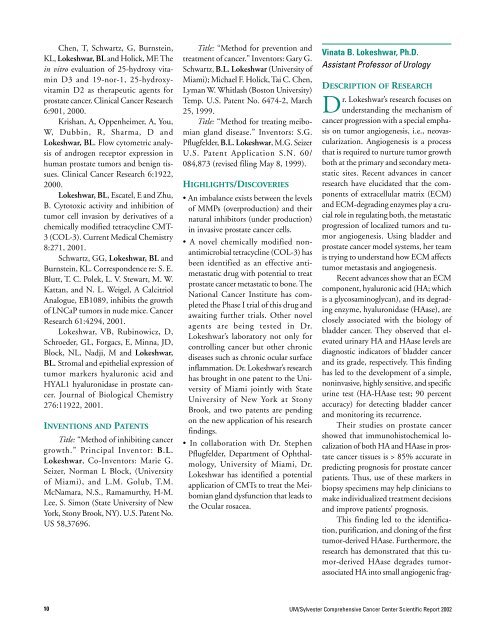tumor cell biology program - Sylvester Comprehensive Cancer Center
tumor cell biology program - Sylvester Comprehensive Cancer Center
tumor cell biology program - Sylvester Comprehensive Cancer Center
Create successful ePaper yourself
Turn your PDF publications into a flip-book with our unique Google optimized e-Paper software.
Chen, T, Schwartz, G, Burnstein,<br />
KL, Lokeshwar, BL and Holick, MF. The<br />
in vitro evaluation of 25-hydroxy vitamin<br />
D3 and 19-nor-1, 25-hydroxyvitamin<br />
D2 as therapeutic agents for<br />
prostate cancer. Clinical <strong>Cancer</strong> Research<br />
6:901, 2000.<br />
Krishan, A, Oppenheimer, A, You,<br />
W, Dubbin, R, Sharma, D and<br />
Lokeshwar, BL. Flow cytometric analysis<br />
of androgen receptor expression in<br />
human prostate <strong>tumor</strong>s and benign tissues.<br />
Clinical <strong>Cancer</strong> Research 6:1922,<br />
2000.<br />
Lokeshwar, BL, Escatel, E and Zhu,<br />
B. Cytotoxic activity and inhibition of<br />
<strong>tumor</strong> <strong>cell</strong> invasion by derivatives of a<br />
chemically modified tetracycline CMT-<br />
3 (COL-3). Current Medical Chemistry<br />
8:271, 2001.<br />
Schwartz, GG, Lokeshwar, BL and<br />
Burnstein, KL. Correspondence re: S. E.<br />
Blutt, T. C. Polek, L. V. Stewart, M. W.<br />
Kattan, and N. L. Weigel, A Calcitriol<br />
Analogue, EB1089, inhibits the growth<br />
of LNCaP <strong>tumor</strong>s in nude mice. <strong>Cancer</strong><br />
Research 61:4294, 2001.<br />
Lokeshwar, VB, Rubinowicz, D,<br />
Schroeder, GL, Forgacs, E, Minna, JD,<br />
Block, NL, Nadji, M and Lokeshwar,<br />
BL. Stromal and epithelial expression of<br />
<strong>tumor</strong> markers hyaluronic acid and<br />
HYAL1 hyaluronidase in prostate cancer.<br />
Journal of Biological Chemistry<br />
276:11922, 2001.<br />
INVENTIONS AND PATENTS<br />
Title: “Method of inhibiting cancer<br />
growth.” Principal Inventor: B.L.<br />
Lokeshwar, Co-Inventors: Marie G.<br />
Seizer, Norman L Block, (University<br />
of Miami), and L.M. Golub, T.M.<br />
McNamara, N.S., Ramamurthy, H-M.<br />
Lee, S. Simon (State University of New<br />
York, Stony Brook, NY). U.S. Patent No.<br />
US 58,37696.<br />
Title: “Method for prevention and<br />
treatment of cancer.” Inventors: Gary G.<br />
Schwartz, B.L. Lokeshwar (University of<br />
Miami); Michael F. Holick, Tai C. Chen,<br />
Lyman W. Whitlash (Boston University)<br />
Temp. U.S. Patent No. 6474-2, March<br />
25, 1999.<br />
Title: “Method for treating meibomian<br />
gland disease.” Inventors: S.G.<br />
Pflugfelder, B.L. Lokeshwar, M.G. Seizer<br />
U.S. Patent Application S.N. 60/<br />
084,873 (revised filing May 8, 1999).<br />
HIGHLIGHTS/DISCOVERIES<br />
• An imbalance exists between the levels<br />
of MMPs (overproduction) and their<br />
natural inhibitors (under production)<br />
in invasive prostate cancer <strong>cell</strong>s.<br />
• A novel chemically modified nonantimicrobial<br />
tetracycline (COL-3) has<br />
been identified as an effective antimetastatic<br />
drug with potential to treat<br />
prostate cancer metastatic to bone. The<br />
National <strong>Cancer</strong> Institute has completed<br />
the Phase I trial of this drug and<br />
awaiting further trials. Other novel<br />
agents are being tested in Dr.<br />
Lokeshwar’s laboratory not only for<br />
controlling cancer but other chronic<br />
diseases such as chronic ocular surface<br />
inflammation. Dr. Lokeshwar’s research<br />
has brought in one patent to the University<br />
of Miami jointly with State<br />
University of New York at Stony<br />
Brook, and two patents are pending<br />
on the new application of his research<br />
findings.<br />
• In collaboration with Dr. Stephen<br />
Pflugfelder, Department of Ophthalmology,<br />
University of Miami, Dr.<br />
Lokeshwar has identified a potential<br />
application of CMTs to treat the Meibomian<br />
gland dysfunction that leads to<br />
the Ocular rosacea.<br />
Vinata B. Lokeshwar, Ph.D.<br />
Assistant Professor of Urology<br />
DESCRIPTION OF RESEARCH<br />
Dr. Lokeshwar’s research focuses on<br />
understanding the mechanism of<br />
cancer progression with a special emphasis<br />
on <strong>tumor</strong> angiogenesis, i.e., neovascularization.<br />
Angiogenesis is a process<br />
that is required to nurture <strong>tumor</strong> growth<br />
both at the primary and secondary metastatic<br />
sites. Recent advances in cancer<br />
research have elucidated that the components<br />
of extra<strong>cell</strong>ular matrix (ECM)<br />
and ECM-degrading enzymes play a crucial<br />
role in regulating both, the metastatic<br />
progression of localized <strong>tumor</strong>s and <strong>tumor</strong><br />
angiogenesis. Using bladder and<br />
prostate cancer model systems, her team<br />
is trying to understand how ECM affects<br />
<strong>tumor</strong> metastasis and angiogenesis.<br />
Recent advances show that an ECM<br />
component, hyaluronic acid (HA; which<br />
is a glycosaminoglycan), and its degrading<br />
enzyme, hyaluronidase (HAase), are<br />
closely associated with the <strong>biology</strong> of<br />
bladder cancer. They observed that elevated<br />
urinary HA and HAase levels are<br />
diagnostic indicators of bladder cancer<br />
and its grade, respectively. This finding<br />
has led to the development of a simple,<br />
noninvasive, highly sensitive, and specific<br />
urine test (HA-HAase test; 90 percent<br />
accuracy) for detecting bladder cancer<br />
and monitoring its recurrence.<br />
Their studies on prostate cancer<br />
showed that immunohistochemical localization<br />
of both HA and HAase in prostate<br />
cancer tissues is > 85% accurate in<br />
predicting prognosis for prostate cancer<br />
patients. Thus, use of these markers in<br />
biopsy specimens may help clinicians to<br />
make individualized treatment decisions<br />
and improve patients’ prognosis.<br />
This finding led to the identification,<br />
purification, and cloning of the first<br />
<strong>tumor</strong>-derived HAase. Furthermore, the<br />
research has demonstrated that this <strong>tumor</strong>-derived<br />
HAase degrades <strong>tumor</strong>associated<br />
HA into small angiogenic frag-<br />
10<br />
UM/<strong>Sylvester</strong> <strong>Comprehensive</strong> <strong>Cancer</strong> <strong>Center</strong> Scientific Report 2002
















